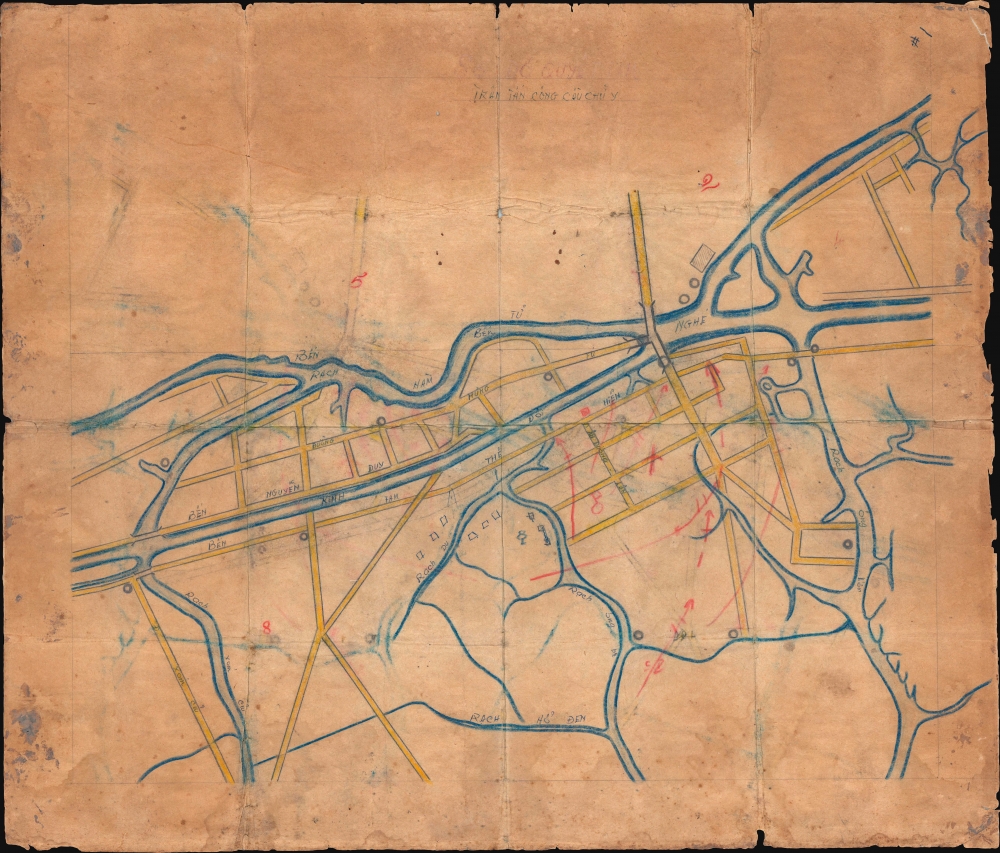This item has been sold, but you can get on the Waitlist to be notified if another example becomes available.
1968 Vietnamese Manuscript Map of the Battle of South Saigon (Battle of Y Bridge)
BattleSouthSaigon-vietnamese-1968$1,250.00

Title
Trân Tấn Công Câù Chư Y.
1968 (undated) 15.25 x 18 in (38.735 x 45.72 cm)
1968 (undated) 15.25 x 18 in (38.735 x 45.72 cm)
Description
This is an original 1968 Vietnam War Viet Cong manuscript battle plan illustrating the Battle of South Saigon (Battle of the Y Bridge). Viet Cong officers undoubtedly used this plan in the field to formulate and communicate tactics.
A Closer Look
The map depicts part of District 8 in Saigon (now Ho Chi Minh City) in what was then South Vietnam. Streets are highlighted yellow, and some are identified by name. The canals Rạch Ông Lớn, the Rạch Kênh Đôi, and the Rạch Bến Nghé, the battle's key landmarks, are identified. The Y Bridge is evident near the confluence of the three canals. Two circles likely mark proposed assault targets. Red arrows drawn over the streets and canals illustrate the planned Viet Cong attack from the south.The Battle of South Saigon
The Battle of South Saigon, also known as the Battle of the Y Bridge, was part of the Viet Cong May Offensive (May 7 - May 12, 1968). The Viet Cong attacked the Y Bridge at 3:45 AM on the morning of May 7. Elements of the 9th Infantry Division were guarding the bridge and returned fire. During the next 5 days, the 9th Division and the Viet Cong fought in an ever-widening area around the Y Bridge and the hamlets of Cầu Mật and Xom Ong Doi. The Americans completely repulsed the attack, and by May 12, the Viet Cong had abandoned Cầu Mật and the other positions they held.The May Offensive
The May Offensive, also called Little Tet and Mini-Tet, was the second phase of the Viet Cong's Tet Offensive (launched on January 30, 1968). It involved attacks throughout South Vietnam from April 29 through May 30, 1968. Targets included Saigon, the DMZ, Huế, and Da Nang. The May Offensive was bloodier than the Tet Offensive, and, with 2,169 killed, May 1968 was the deadliest single month for the U.S. armed forces during the war. The South Vietnamese lost 2,054, and the PAVN and Viet Cong lost over 24,000.The Y Bridge
The Y Bridge was originally designed by the French in 1937. Construction began on October 28, 1939, when Governor General Brévié laid the first stone. Construction halted after the Japanese invasion in 1940 but soon resumed, and the bridge was opened on August 20, 1941. The Vichy government celebrated the achievement, stating that the bridge would allow Cholon (the Chinese neighborhood in Saigon) to develop. The bridge played a role in both the French-Indochina War (1946 - 1954) and the American Vietnam War (1955 - 1975). It was refurbished in 1992 and completely rebuilt in 2007 to allow for a higher clearance on the East-West Highway.Provenance: Major General Ira A. Hunt
This archive was part of the papers of Major General Ira Augustus Hunt Jr. (1924 - 2022), an American Army officer, historian, and author. During the Battle of South Saigon, Hunt was Chief of Staff of the participating 9th Infantry Division and as Commanding Officer of its 1st Brigade. After the war, Hunt was an Investigating Officer for the U.S. v. Henderson court-martial. Born in Lincoln, Nebraska, Hunt entered the United States Military Academy at West Point, graduating in 1945, when he became a second lieutenant in the Corps of Engineers. He was sent overseas, where he served in several post-war engineer assignments in Europe. A distinguished military and academic career followed, including multiple prestigious degrees and service in Korea. During the Vietnam War (1955 - 1975), he served as Chief of Staff of the 9th Infantry Division and as Commanding Officer of its 1st Brigade. After Vietnam, he was made Assistant Commandant of the Engineer School at Fort Belvoir, then Deputy Chief of Staff for Training and Schools at Headquarters TRADOC, Fort Monroe, Virginia. He retired in 1978, after which he wrote three books: The 9th Infantry Division in Vietnam: Unparalleled and Unequaled, Losing Vietnam: How America Abandoned Southeast Asia, and My Lai Cover-Up: Deceit and Incompetence.Condition
Fair. Manuscript. Wear along original fold lines. Slight loss at a few fold intersections. Toning and soiling. Some offsetting.

